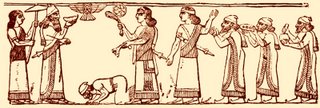Sunday, August 06, 2006
Planar Close Packing
Troy R. Bishop wrote an article titled Starring the Circle where he shows the connection between the Star of David and atoms. This sounds important because atoms are the bricks of the world and the question, which we are dealing here with is in fact: how does the six pointed star represents the world?
Each atom (or coin, in his illustration) if not on an edge is touched by exactly six neighboring coins
This arrangement is known in solid-state physics, which concerns itself with the way atoms arrange themselves together in solid matter, as planar close packing…this pattern is repeated throughout the entire arrangement …the Star of David… is inherent in a figure based on seven circles.
Troy R. Bishop goes on and shows that the number seven represents the maximum possible number of manifestations of the number three (The Star of David is made from two triangles. Triangle is based on three angles, that's the origin of its name).
There are just seven possible combinations of any three items, alone or in combination, and they are:
1. First item alone
2. Second item Alone
3. Third item alone
4. First item and second item together
5. First item and third item together
6. Second item and third item together
7. First, second, and third item together
The Star of David is first and foremost a geometric shape, a hexagram. The language of geometry (shapes) is translated perfectly into the language of Math (numbers). No wonder there is so many different articles calculating the numbers behind this shape. What I personally like in Troy R. Bishop's article is the poetic sound of the words Planar Close Packing.
Each atom (or coin, in his illustration) if not on an edge is touched by exactly six neighboring coins
This arrangement is known in solid-state physics, which concerns itself with the way atoms arrange themselves together in solid matter, as planar close packing…this pattern is repeated throughout the entire arrangement …the Star of David… is inherent in a figure based on seven circles.
Troy R. Bishop goes on and shows that the number seven represents the maximum possible number of manifestations of the number three (The Star of David is made from two triangles. Triangle is based on three angles, that's the origin of its name).
There are just seven possible combinations of any three items, alone or in combination, and they are:
1. First item alone
2. Second item Alone
3. Third item alone
4. First item and second item together
5. First item and third item together
6. Second item and third item together
7. First, second, and third item together
The Star of David is first and foremost a geometric shape, a hexagram. The language of geometry (shapes) is translated perfectly into the language of Math (numbers). No wonder there is so many different articles calculating the numbers behind this shape. What I personally like in Troy R. Bishop's article is the poetic sound of the words Planar Close Packing.
Black Obelisk

Picture copied from Wikipedia entry:Black Obelisk
There's a sort of a six-pointed star on the "Black Obelisk" of Shalmaneser III (858-824 BC) discovered in Nimrud in northern Iraq. The obelisk had been erected in 825 BCE. It is the earliest ancient description of an Israelite. Archaeologist Sir Henry Layard discovered it in 1846.
There are twenty reliefs on this obelisk describing subdued kings. In one of them this six-pointed star is above King Jehu's head. The translation of the Assyrian caption above the scene is:
The tribute of Jehu, son of Omri: I received from him silver, gold, a golden bowl, a golden vase with pointed bottom, golden tumblers, golden buckets, tin, a staff for a king [and] spears.
Subscribe to:
Comments (Atom)